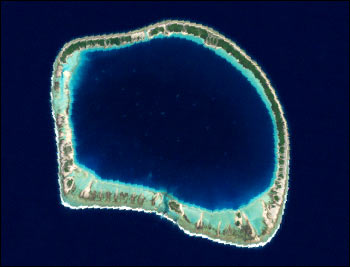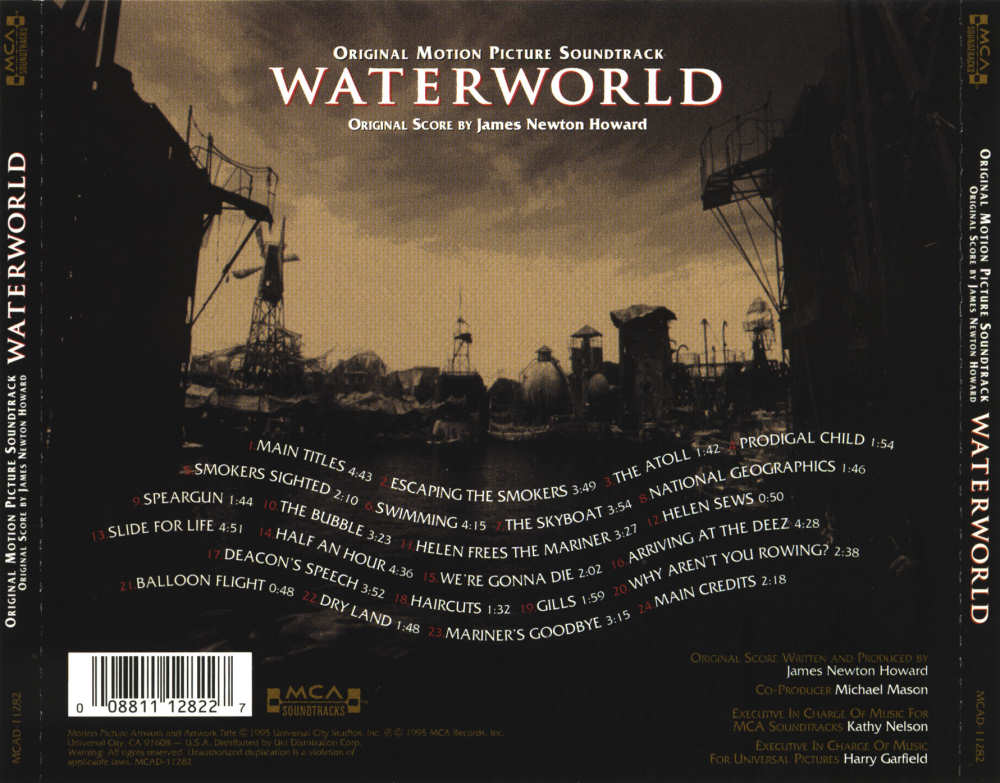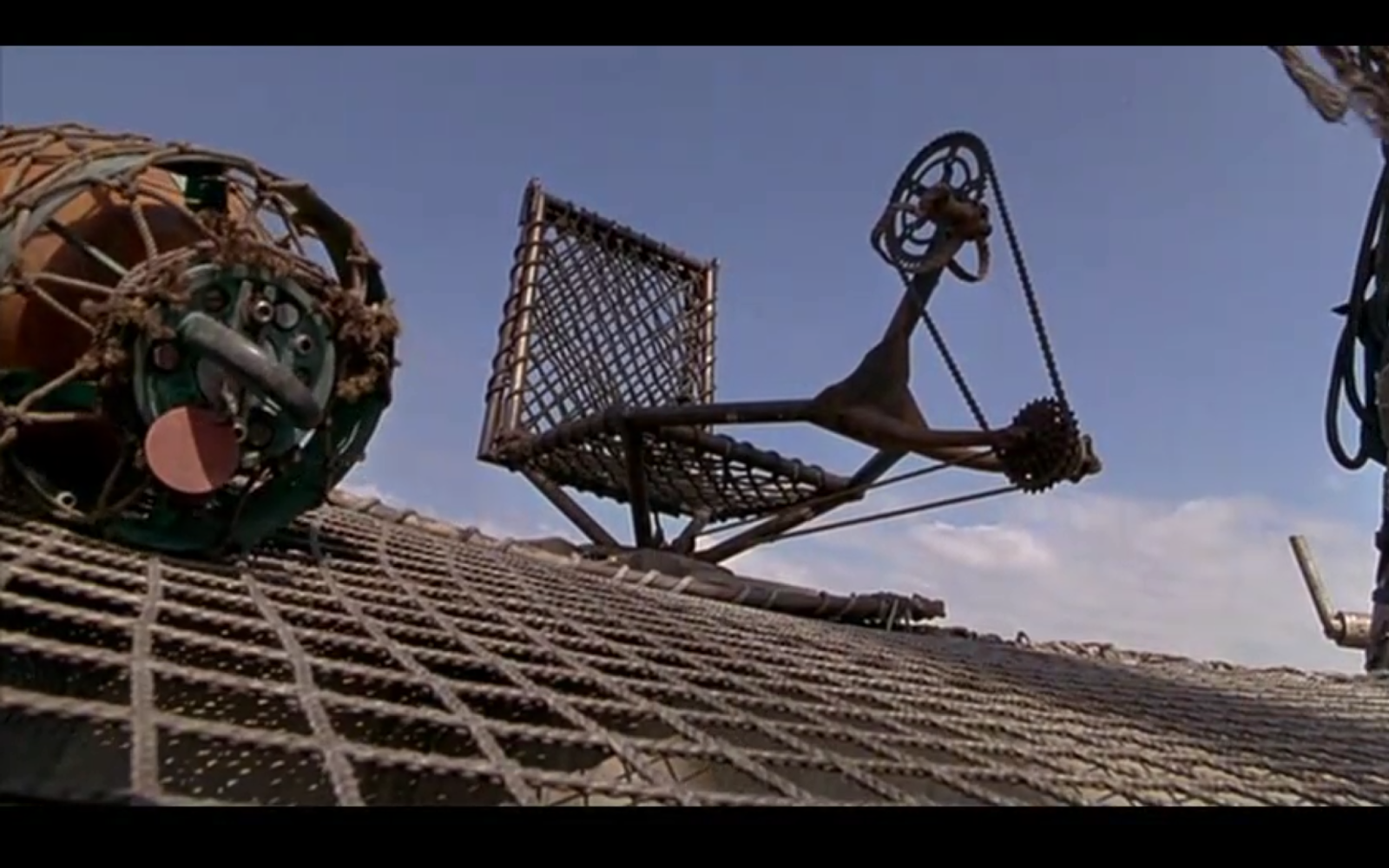"The future... The polar ice caps have melted, covering the earth with water. Those who survived have adapted... to a new world."
-Opening Narration
Note: *SPOILERS* ahoy. But if you haven't seen this yet, seriously. Also, this review pertains to the fan-made "Ulysses" cut, the most complete version of the film, which smooths out the choppiness of the theatrical cut's storyline.
When I first thought to review Waterworld, my intention was to tear it apart scene by scene. However, after my third viewing in twenty-four hours, I had an unexpected revelation, something certain to raise awkward silence in future conversation and make me the laughing stock of cinema elitists everywhere. I love Waterworld.
 |
| Nooooo! |
Yes. From opening shots of "The Mariner" (Kevin Costner) drinking his own pee-pee, to the part where "Dennis Hopper" (Dennis Hopper) encourages a young girl to start smoking cigarettes, all the way to the end, where Mariner leaves the woman and girl on the newly discovered Dry Land to presumably mate with the fat guy and the old man, restoring the proper way of life on solid ground. I love it all.
 |
| Dennis Hopper most of all. |
Now that's not to say I'm unaware of the movie's faults. In fact, it's overflowing with them in nearly every scene. However, faults are no guarantee a film lacks entertainment value (for proof, watch Troll 2). With that in mind, let it be said Waterworld is a American cinematic phenomenon, albeit a cult one. On its most basic level, the film is made to entertain, and, having not lost interest after repeat viewings, I can comfortably say it succeeds.
I first saw Waterworld in the theater with my mom when it was new, sometime in late July/early August, 1995. I was seven, and though I don't remember any negative feelings about it, I must not have been overly excited as I didn't see it again until now, in September 2014. There was little I remembered about the movie: Costner drinking pee, bad guys on jet-skis, Dennis Hopper acting crazy. The film's exaggerated reputation as a major flop was unknown to me until years after. For my seven year old mind, it was just a big summer movie. Having somewhat sharpened my perception since then, I now feel I've got a solid grasp on what Waterworld is going for as a film. Putting aside the cinematic stigma Waterworld will undoubtably carry forever, please allow me to discuss the film as it is, spotlighting both its foils and its feats.
The film starts with the "Universal" spinning globe logo sans music, but never cuts away. The "Universal" title disappears as the point-of-view zooms in to the water enveloping all the land, a gimmick falling in the awkward ground between cool and embarrassing, and a voice tells us it was all caused by the melting of the polar ice caps. Unfortunately the filmmakers couldn't simply "Google" it in 1995 or they would've learned in mere seconds this is impossible. Seeing as everything in the film that follows rests upon that very idea, there it is, right off the bat, a faulty take-it-or-leave-it premise. Because I don't see the need to strictly take everything I encounter in life seriously, I ran with it. And for those of you prepared to ride off on an intellectual high-horse, just remember no one thinks you're cool.
Coming through the clouds to the great blue future world, the camera focuses us in on a single sailboat, a trimaran, known as such for its triple-hull design. The boat is one of my favorite things about the film. It has an authentic coziness to it, making it feel like the Mariner really lives there. The Trimaran is filled with artifacts from the sunken world, and identifying them in the background during the scenes on the boat is a pleasure all its own.
The audience is also treated to the first composition of the soundtrack by James Newton Howard. It breathes mysticism into the picture and works very well in my opinion. The music has a certain tribal feel to it as well, making it sync with the survivalist state of humanity in the water world. All in all, the soundtrack is a seamless fit for the film, giving it a layer of needed emotional depth.
As for the Mariner, our first glimpse of him is a rather unfortunate one, a between-the-ankles shot of the yellow body fluid draining into a dirty plastic cup. The camera pans up high enough for us to see the urine poured into a filtration system and pumped through. Only after he pours the filtered pee-water into a cup and takes a sip do we finally see the Mariner's face.
 |
| See? All your reservations about Waterworld were unfounded. |
This is without a doubt one of the biggest WTF moments in cinematic history. If you had two-hundred million dollars resting on a motion-picture (most expensive film ever made at the time), a motion-picture getting all kinds of negative press before being seen (mostly due to said budget), why would you take the risk of introducing the hero in this fashion? I see what they were going for, of course, which is an in-your-face statement about the harshness of living in this future world. It certainly complies with the rest of the film, but with all the writers and countless drafts of the screenplay, couldn't someone come up with a better introduction than this? They marketed this movie to kids, after all; it had its own toy line and video games. What kid is going to view this as anything but a grown man drinking pee? It's no wonder the toys were quickly shuffled to the bargain bin.
 |
| *Pee Filter not included |
But enough about pee drinking. The next thing that happens is the Trimaran gives a forceful lurch, and we see the Mariner has been trolling for something. Whatever it is, he must've found it, because he soon dives into the ocean and disappears for a long time. In his absence, we get to see some nice shots of different areas on the boat, which further sets the feeling of isolation, as well as some more insight into life aboard the trimaran. A wind chime made of fire sprinklers. A harmonica that hums softly as the sea breeze passes through. He even has a small tree with a few green lemons growing. It's all very peaceful.
The next sequence is a bit too unclear. A timer set by the Mariner goes off, the line begins winding, and an air sack with a bag of relics floats up to the surface. Even with the countless times I've watched this film, I'm still in the dark about how it actually works. How did the bag get down there? How did it get to be filled with air? Correct me if you can make better sense of it.
 |
| Above: What are we looking at? |
We get another shot of the lemon tree, when a hand reaches from offscreen and picks all the fruit. Whose hand is it, the movie asks? Not Costner’s. He's still underwater, but soon pops up with a pair of boots straight out of 1986. He didn't have them when he dove in, so he must've got them from the ocean floor. How did he do that? We'll find out soon. While he's trying the boots on, he realizes there's another boat nearby. He panics from being taken off guard and dashes over to his mounted harpoon gun, aiming it at the other boat.
The appearance of the second boat is where we start getting the bigger picture of life in Waterworld. On it is a lone sailor, his first words being "Don't worry, I didn't board you," in Hindi. We immediately suspect him of foul play due to the lemon thievery just witnessed. I mean, it's not like there's anyone else around. While we are suspicious of him, he is equally wary of the Mariner, commenting on the great timespan he was underwater. Mariner replies in Hindi that he was fixing his hull, which has holes allowing him to get his head above water and breathe. The second guy notes his accent and starts speaking English.
 |
| Would you trust this man? |
Why they went to the trouble of trying to convey the multiple languages used in Waterworld is a bit of a head scratcher, since there's only three or four small bits of dialogue not in English throughout the entire film, and one of them is only used to confirm two parties both speak English. I can see why people would take issue with everyone speaking English in this version of the future, but the filmmakers didn't really make the effort to carry it far enough anyway, so it feels like extraneous detail.
So to sum up what we learn from the first exchange of dialogue in the film, the most important detail is the value of dirt. Yes, dirt is the most valuable commodity in Waterworld (Why don't people love this movie again?). Further, "Atoll" is the name given to a colony of people who have set up a ring shaped living structure on the water, the word atoll being the definition for ring shaped coral reefs. A nice touch, if you ask me.
 |
| An actual atoll |
 |
| Atoll - Waterworld |
 |
| "Cost you a handful of DIRT." |
However, there is honor too, evidenced by the code of the Drifters, a sort of brotherhood wherein they always stop for each other when meeting on the sea. It is customary for a trade to occur any time two drifters meet, though the custom is probably also an excuse for mere human contact during lonely months on the endless ocean. Some may not see the point, but the code is something real for drifters to cling to, something to live for. It is a key for maintaining sanity in a mostly empty world.
The second drifter’s disregard for the code casts him into further suspicion. Just when the Mariner lowers his harpoon, the drifter turns down the customary trade, saying Mariner need not concern himself, as he had just come from an atoll with all the supplies he needs (his mention of the atoll and directions to it advance the plot). The drifter's ignorance of the code holds importance as an early sign of breakdown in the way of life built up on Waterworld. There is an underlying urgency that begins to emerge. Something needs to change or human life will end.
"Nothing's free in Waterworld," is the Mariner's response. There are no gifts. With the precious little in the world, everything is commodity based, making simple materials like dirt and paper highly valuable, as limited amounts survived the flood. As such, a drifter could never have "all the supplies he needs." Mariner casts an uneasy look, knowing something is off.
 |
| The great flood apparently spared the white trash, unfortunately. |
The Smokers, the fourth and most dangerous sect of society shared with atollers, drifters, and slavers are one of the most interesting aspects of Waterworld, being pirates of the future and riding an assortment of power watercraft, including jet skis. How do they get power? By using a cheaply refined oil called "Go-Juice," allowing their boats to run but causing lots of smoke.
How these machines are still operating after hundreds of years in salt water, running on cheap fuel and without any possible place to receive proper maintenance is one of the great unanswered questions about the film's mythos (according to one of the producers, Waterworld takes place around 2500). With the excessive, consuming lifestyle displayed by the smokers in the film, their complete disregard for resources as opposed to the calculated survival rationing of the atollers makes it doubtful there would be enough fuel left to keep all those jet skis running after hundreds of years. Summer days on the lake taught me a few joyrides would burn through a full tank, so constant trips around the ocean would be unheard of. The suspension of disbelief factor is obviously raised with the appearance of the smokers, but again I say just go with it, for the sake of entertainment.
The smokers have already spotted the two boats as well as the bag the Mariner brought from down in the ocean, still floating in the water a short distance away. The drifter checks the wind, knows he can make an escape, and tells the Mariner "Forget the bag, it's not worth it! You'll never make it with your sails down!" With as many repeat viewings as I've had, this bit troubles me. The film later tells us no one except the Mariner actually knows the "real" world is underneath the water, so how would anyone else recognize the purpose of the bag? Now it's possible the smokers are just curious and plan to pillage everything as they like to do, but the second drifter also seems to know the purpose of the bag. It simply doesn't add up, carelessness on the part of the writers. I'm guessing they were so occupied figuring out how to cinematically introduce this conceptual world they blanked on the small details. I don't know. Maybe they never intended anyone to watch this more than, say, 30 times, like I have this week.
The second drifter begins to sail away, but not before revealing to the Mariner he stole all his lemons. Mariner flips a switch, though, and his boat goes all steampunk, raising the sails almost instantly. We see the reactions from both the second drifter ("What the hell?") and the smokers ("I've never seen that before!"), revealing this is highly unusual for Waterworld. The only thing I can possibly conclude on the origins of the Trimaran is that Mariner built much of it himself with parts acquired through trade, though it's never explained in the least, so the filmmakers are again forcing us to accept something in the name of a more entertaining film. The Mariner has a bad-ass boat. How it came to be is of no concern.
After the transformation, Mariner starts to move for his bag of relics. "Sweet Joe, he's going for it," says one of the smokers. His use of the name Joe is a subtle detail only noticeable upon repeat viewings, as we learn later in the film the smokers home is a very busted up Exxon Valdez, and they consider its captain, Joe Hazelwood, to be a saint. As it is likely most people who viewed Waterworld only did so once, it is a detail left for the cultic viewers like myself, those unafraid to plunge to the depths again and again, who appreciate the film for what it is, and what it wants to be, instead of dismissing it for not meeting expectations. As such, I love that small attention to detail, as it acknowledges those viewers and maintains consistency with the characterization of the smokers.
The smokers close in, but Mariner gets to the bag first, swinging around and scooping it up. The next bit is one of my absolute favorites in the film, as it exudes retribution and bad-assery. Mariner is in the clear to sail away, but when he spots the drifter he makes plans for a slight detour. I have to give Costner credit here, as he plays it all from the face and body language. Without a word, he says "I'm gonna get that sonofabitch who stole my fruit," narrowing his eyes and turning to starboard. The drifter glances back and does a double take, in disbelief at the speed of Mariner's approach.
He attempts to increase speed to no avail, and the Trimaran quickly catches up. The drifter dives down on the deck as the Trimaran passes right over, knocking over his mast like a dead tree as it speeds on. The drifter stands up and with a stupid look on his face (rather hilarious in spite of the circumstances) watches the Mariner sail away, still dazed by everything that has just happened.
He seems to momentarily forget the smokers, but then turns around as they catch up to him guns blazing before jumping on his vessel and striking him down with a club. We hear his final pained scream while we get a shot of Mariner's face, completely without mercy for the fallen drifter. He sails on. The scene is exciting and effective, showcasing one of the films strengths, the cool blend of sailing and action, giving a futuristic swashbuckling feel. Not to mention, who in the audience didn't absolutely love seeing that scheming thief get what was coming to him? And of course the real purpose of the scene, informing the audience Mariner is one tough mother.
---
Here ends the first scene and Part One of my Waterworld write-up. Check back for Part Two!






























